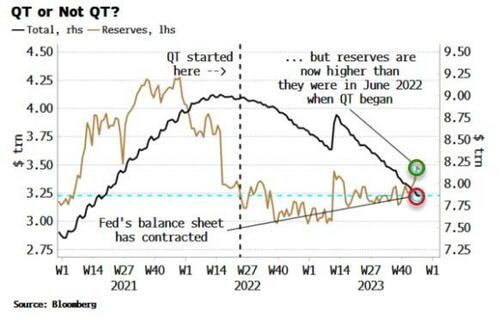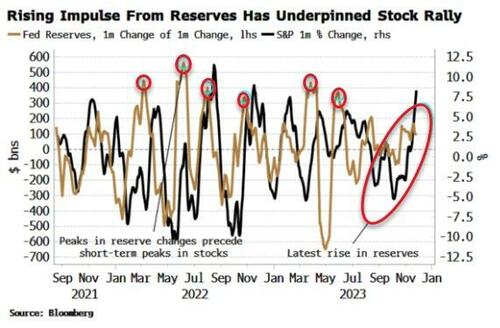Via ZeroHedge, November 28:
Authored by Simon White, Bloomberg macro strategist,
Quantitative tightening isn’t working. At least not in the way you’d expect it to, with central-bank reserves rising, not falling. On top of that, excess liquidity remains high and is increasing, while rates are becoming less restrictive. Stocks have thus been rallying, and will continue to experience tailwinds as long as liquidity conditions remain favorable.
Soft, hard or no landing?
When it comes to stocks, at least in the medium term, it matters little. What does matter is liquidity, and its recent rise explains one of the best November performances in the S&P over the past 90 years.
Liquidity conditions have been improving in three key ways:
central bank reserves,
excess liquidity,
and the restrictiveness of rates.
With no sign that any of them is about to turn much lower imminently, stocks will continue to enjoy supportive liquidity tailwinds once the current overboughtness has been worked out.
The rise in reserves is the most surprising. The Federal Reserve began QT in June 2022; since then, its balance sheet has contracted by more than $1 trillion to sit at just under $8 trillion. But reserves, which underpin deposits and the liquidity of the banking system, are now higher than in June last year.
The change in the change of reserves typically leads the one-month performance of the S&P (as shown in the chart below). Reserve growth began to accelerate about a month ago, the same time as when the market began to rally.
The key factor leading to rising reserves despite ongoing QT is the government’s decision to fund a significant proportion of the fiscal deficit using T-bills. Make no mistake: if they had not, risk assets this year would have been in a much more precarious spot.
Funding much of the deficit using bills as opposed to longer-term debt has allowed money market funds (MMFs) to absorb the new supply of government debt. The Fed’s higher-for-longer message has kept the rate on bills higher than the rate on the reverse repo facility (RRP), meaning that MMFs have been incentivized to draw down on the RRP to buy bills.
If, instead, a non-bank corporate or a household were to have bought the bills, reserves would have fallen as they would have had to use bank deposits to pay for them. MMFs drawing down on the RRP, on other hand, mitigates the fall in reserves.
We can see how the liabilities on the Fed’s balance sheet have changed over the last month in the chart below. The fall in the RRP of ~$130 billion more than offsets the ~$100 billion fall in the total size of the balance sheet, driven by QT as the Fed reduces the amount of assets it holds. That would mean about a $30 billion rise in reserves.
But reserves are in fact up much more than that as they have been boosted by the $150-$160 billion fall in the Treasury’s account at the Fed (the TGA). When the Treasury draws down on the TGA, reserves rise.
The resulting almost $200 billion rise in reserves has been a formidable tailwind for stocks over the last month.
Further, with the Treasury’s most recent quarterly refunding announcement the government implied they would continue skewing issuance towards bills, meaning that with still ~$1 trillion in the domestic RRP this dynamic can continue for the time being. This is a pro-cyclical fiscal deficit on speed.
Adding to stock tailwinds is excess liquidity – real money growth minus economic growth of the G10 countries in dollar terms – which continues to rise. By now it might have been expected to start rolling over, but there is little sign of that yet. Buoyant excess liquidity conditions since around March this year have been a key driver of this year’s stock rally....
....MUCH MORE


